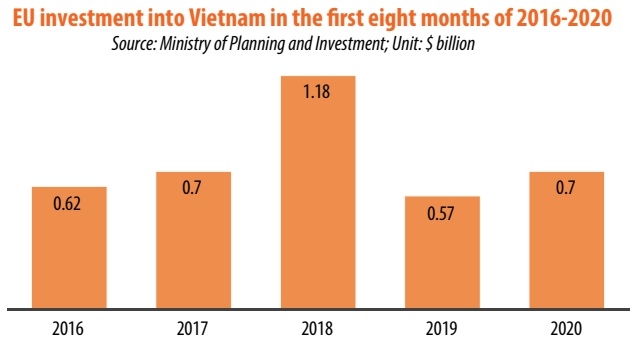Rise of EVFTA benefits to materialise
 |
According to the latest statistics from the Ministry of Planning and Investment (MPI), EU investment into Vietnam reached about $693 million in the first eight months of 2020, up from $570 million in the same period of 2019.
These figure is far lower than those from Singapore ($6.54 billion), South Korea ($2.96 billion), Japan ($1.65 billion), and China ($1.75 billion), which currently represent Vietnam’s top foreign investors.
Experts said that doing business in Vietnam is not without its challenges, as there are still fundamental improvements to be made so that the business environment can become more dynamic and accessible. Unlike other foreign investors, those from the EU have their own requirements, such as transparency and a predictable environment. Three of the challenges commonly discussed are administrative procedures, and some issues relating to coordination in legislation.
Nguyen Mai, senior economist and chairman of the Vietnam Association of Foreign-Invested Enterprises told VIR, “EU investors seek administrative reforms, a predictable legal environment, and efficient enforcement of laws. Although some improvements have been made, further actions are necessary to benefit from the landmark agreement and increase the country’s attraction.”
As seen in the EVFTA and the EU-Vietnam Investment Protection Agreement (EVIPA), transparency and predictability are among the prioritised issues. “This means once Vietnam deals with all the remaining hurdles, capital inflows from the EU may increase. But this will take time,” Mai noted.
However, Mai agrees with lawyer Nguyen Thanh Ha from Vietbid Consulting Co., Ltd. that the EVFTA offers earlier strong motivations to imports and exports and will boost trade rather than investments.
One month after the agreement’s enforcement, Vietnam has seen an increase in trade with the partner. According to statistics from the Ministry of Industry and Trade, in August the country reported an on-month rise of 10 per cent in the number of orders for fisheries exports.
In addition, Vietnam’s rice exports to the EU also developed positively, with this commodity’s price increasing by $80-200 per tonne on average.
Meanwhile, the EU’s funding has not changed much in the Southeast Asian country. Nevertheless, the EU only remains among the top ten foreign investors in Vietnam, partly because of serious developments of COVID-19, which is preventing business delegations from the bloc to come to Vietnam and look for new projects. Experts said that at least during this year, the bloc’s capital influx may not improve. However, both sides have high hopes on long-term cooperation between the EU and Vietnam, which may also pave the way for new cash injections from the bloc.
According to the European Chamber of Commerce in Vietnam, it is manufacturing – particularly sectors like textiles, IT, machinery, and agriculture – that may see higher engagement from EU investors under the EVFTA. With this new-generation trade agreement, Vietnam should have a safe place on the radar of EU financiers, including those already in the country for many years, who are open to expanding their operations given the right steps and measures.
What the stars mean:
★ Poor ★ ★ Promising ★★★ Good ★★★★ Very good ★★★★★ Exceptional
 Tag:
Tag:
Related Contents
Latest News
More News
- Ho Chi Minh City backs $2 billion AI data centre with dedicated task force (January 06, 2026 | 08:43)
- PM sets January deadline for high-speed rail consultant (January 06, 2026 | 08:40)
- New decree spurs on PPP implementation (December 31, 2025 | 19:01)
- Global alliance develops $1 billion AI data centre network in Vietnam (December 30, 2025 | 10:08)
- Standing out in the Chinese outbound investment wave (December 29, 2025 | 10:29)
- Bright spots obvious in foreign investment mission (December 29, 2025 | 09:00)
- Ho Chi Minh City hits $8.37 billion in FDI (December 29, 2025 | 08:28)
- Vietnam and UK cooperation backs finance talent for IFCs (December 27, 2025 | 16:31)
- Global partnerships key to Vietnam’s IFC development (December 26, 2025 | 16:18)
- Vingroup pulls out of bid to invest in North-South high-speed railway (December 26, 2025 | 11:42)























 Mobile Version
Mobile Version